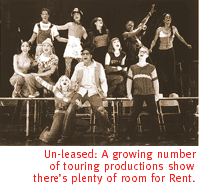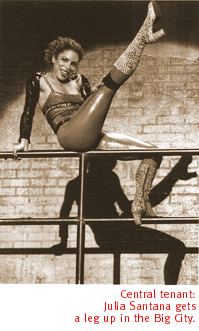

|

'Rent' Comes To Tucson.
By Margaret Regan
NOWADAYS RENT IS a mini-industry.
Going strong on Broadway since its opening two and half years
ago, the groundbreaking rock musical has garnered every theatre
award from the Pulitzer to the Tony. One of two American touring
companies arrives in Tucson Tuesday for a weeklong run at Centennial
Hall. Another troupe is in Canada, still another in London, and
a third overseas show just opened in Australia. And those are
just the English-language productions.
"It is an American story," says John Corker,
who manages the farflung Rent empire. But foreign audiences
also are clamoring for the end-of-the-millennium story about young
artists in America, so the Jonathan Larson story has gone into
translation, interspersed with foreign "cultural idioms to
make it work" abroad. A Japanese company already is singing
the show's bohemian tales of New York's East Village in Japanese,
and a German cast is in rehearsals for an all-Deutsch production.
 So what accounts for the show's runaway success with mass audiences
and critics alike? It is, after all, full of such un-Broadway-like
characters as an HIV-infected punk rocker and an activist lesbian
performance artist.
So what accounts for the show's runaway success with mass audiences
and critics alike? It is, after all, full of such un-Broadway-like
characters as an HIV-infected punk rocker and an activist lesbian
performance artist.
For Corker, the secret is creator Larson's "ability to speak
directly to the generation from which his characters are drawn.
(He conveyed) the voice of alienation and artistic struggle, the
fear of loneliness and alienation. The show resonates and it lands."
 It's no small irony that Larson's heirs have become rich from
his tale of the woebegone artists of Alphabet City, Greenwich
Village's easternmost zone, where the streets are littered with
glass, and broken-down tenements are squeezed between desolate
high-rise public housing blocks. The show's more widely publicized
irony is that the 36-year-old Larson, who wrote the book, music
and lyrics, died on the eve of the play's first performance, after
years of struggle in the New York theatre scene.
It's no small irony that Larson's heirs have become rich from
his tale of the woebegone artists of Alphabet City, Greenwich
Village's easternmost zone, where the streets are littered with
glass, and broken-down tenements are squeezed between desolate
high-rise public housing blocks. The show's more widely publicized
irony is that the 36-year-old Larson, who wrote the book, music
and lyrics, died on the eve of the play's first performance, after
years of struggle in the New York theatre scene.
Rent, his first success, is an affecting depiction of
the Village world he inhabited for a decade and a half after college,
a district of marginalized artists, painters and videographers
and musicians and performance artists. The impoverished young
people of his story are drawn from the real-life waves of artistic
refugees from convention who have washed onto New York City's
low-rent districts at least since the 1920s. Larson was one of
these idealistic Middle American kids who regularly descend on
the city's crumbling tenements, foregoing, say, law school, in
favor of making cutting-edge art. Larson's particular dream was
to write a new kind of Broadway musical, one that would use contemporary
music to tell stories about real people.
"His objective was to do a new form of musical theatre,"
says Corker. "He used to say, 'My generation doesn't go to
Broadway.' "
WORKING AS a waiter for 10 years in a SoHo diner, Larson
eventually hit on the idea of updating Puccini's opera La Bohéme.
That late 19th-century opera, which Larson had first seen in a
puppet-show version as a child, romanticized bohemian life in
1830s Paris. Rent would replace La Bohéme's
characters with arty counterparts from millennial New York. The
opera's poet, Rodolfo, becomes Roger, the punk rocker who's HIV-positive,
and Rodolfo's love Mimi, a seamstress fatally ill with consumption,
is Rent's Mimi, an S&M dancer with a bad case of AIDS.
Larson transformed another Puccini couple into a pair of lesbian
activists, and still another into gay lovers. The grasping landlord
Benoit becomes Benny. The opera's painter Marcello translates
into Mark, a video artist and narrator who is the most Larson-like
character.
Larson's gave his last interview to a New York Times reporter
after the final dress rehearsal, hours before he died unexpectedly
of an aortic aneurysm, a broken heart vessel. Describing the opera
connection, Larson said, "I analyzed the libretto, broke
it down beat by beat. Who would these characters be in my world?"
So closely does Rent follow the structure of La Bohéme,
that many of its songs, rocking though they are, are specifically
linked to the opera's arias. Corker points out the play's recurring
answering machine messages, devices that connect the major songs,
reprise the opera's "recitif" passages.
"He took the traditional structure of opera and updated
it," Corker says. The show is an exuberant rock anthem of
35 songs, performed by seven principles and an ensemble chorus
of eight, with four musicians right on stage. The operatic allusions
hidden in such bouncy numbers as "Glory" are part of
the work's intergenerational appeal, he adds. "The opera
connection is another draw for the older audience."
 Larson's own early death was completely unexpected, but he had
grown up in the age of AIDS and spent his adult life in a neighborhood
where young people were regularly felled by the disease. Larson
certainly celebrates the life--the clever song "La Vie Bohéme"
is an ode "to hand-crafted beers made in local breweries/to
yoga, to yogurt, to rice and beans and cheese"--but the modern
plague gives the musical a dark cast.
Larson's own early death was completely unexpected, but he had
grown up in the age of AIDS and spent his adult life in a neighborhood
where young people were regularly felled by the disease. Larson
certainly celebrates the life--the clever song "La Vie Bohéme"
is an ode "to hand-crafted beers made in local breweries/to
yoga, to yogurt, to rice and beans and cheese"--but the modern
plague gives the musical a dark cast.
"This is the first musical where AIDS is a fact of life,"
Corker says, "but it's only one element. It's about being
alive and sexual and finding a way for yourself in life."
The show, as its title implies, is also about money. It's about
commerce clashing with bohemia, about an economy where artistic
imagination reaps the lowest dividends. It's about how unromantic
it is to live in poverty for years on end, in noisy, dangerous
apartments, artistic dreams notwithstanding. And it's about how
some artists fail, and die.
The characters are all renters, on temporary leases in more ways
than one. They never get a chance to own a piece of the American
dream. That's a pity. Because, as Mark sings, "When you're
living in America, at the end of the Millennium, you are what
you own."
Rent plays Tuesday through Sunday, November 17
through November 22, at Centennial Hall at the University of Arizona.
Evening showtimes are 7:30 p.m. Tuesday through Thursday; 8 p.m.
Friday and Saturday. Matinees are at 2 p.m. Saturday and Sunday.
Tickets are $36 to $48, with some student discounts available
on opening night. For more information call the box office at
621-3341. A limited number of reduced-price tickets for
seats in the first three rows of the orchestra will be available
for every show. The $20 tickets, limited to two per buyer, will
be offered at the box office starting two hours before each performance.
There are no age restrictions on the buyers, who must pay cash
only.

|
 |





